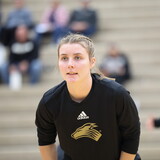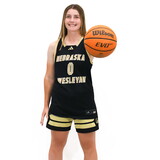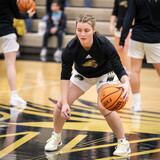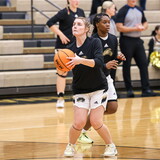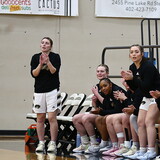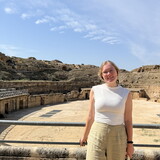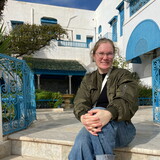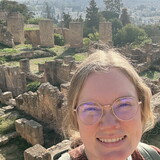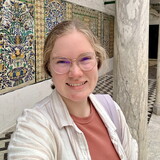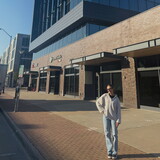Nebraska Wesleyan University adjunct professor Randy Bowdish provided his students with more than 30 pages of resources.
From that, students gathered a handful of facts:
- The body of a murdered vagrant turned up in a ditch at 82nd and Saltillo. He’d been shot in the forehead at close range.
- The autopsy results showed the man tested positive for bubonic plague.
- A few days after the murder, a cryptic message on a downtown parking garage said, “Vidra is coming.” The next day, police officers found more graffiti on a downtown building that read, “Rudra is coming.”
- At the same time, police responded to a break-in and theft of equipment at a university bioengineering lab.
- Police also reported an exchange at a downtown bar between a female university student and two unidentified men who told her that “Rudra would play a key role in an upcoming spring football game” and that “Rudra is a real killer.”
Students in Bowdish’s “Special Topics—Terrorism” class poured over fake police reports, autopsy reports, press releases, and plentiful resources on counterterrorism.
Their assignment, however, wasn’t to solve the crime; rather Bowdish challenged them to assume the role of counterterrorism experts with the Department of Homeland Security. Their grade for this wargame would be based on how well the students could assess the situation with the information they had and decide either how to prevent or respond to the possible terrorist attack.
“This exercise puts everything together that we’ve learned in class,” said Bowdish, a retired U.S. Navy captain. “I’m challenging them to go to that next level.”
Six teams of three students — many of them sophomore political science majors —took turns presenting their case. The audience — made up of their fellow classmates and Bowdish — served as mock members of the mayor’s office and police and fire departments.
Group number one projected a possible aerial dispersal of pneumonic plague would be spread over fans attending the upcoming spring football game. The group recommended a no-fly zone over the football stadium.
Another group recommended canceling the spring football game in an effort to thwart the terrorists’ plans.
And yet another group suggested all 80,000 people attending the spring game be evacuated and quarantined.
And another group who recognized Rudra as a reference to the Hindu god of storms and death called for an investigation of local Hindu groups.
Each group received frank grilling from Bowdish.
“How large is this no-fly zone of yours?” he asked group one. “Are you saying you want to shoot down aircraft? Over Lincoln? What if it’s just some schmuck who doesn’t know how to use his radio?”
To another group: “Your stadium evacuation will be chaos. You know people will die trying to get out of there. Are you prepared for that?”
“You want to investigate Hindu groups? How is that not religious profiling? Are you ready for lawsuits?” Bowdish questioned yet another group.
Students admitted Bowdish’s questions were intimidating.
“I really wanted to impress him,” Nathan Dawdy, a sophomore from Lincoln, said of his professor. “This is one of the classes I’ll remember for a long time. I’ve just really been impressed by the breadth of knowledge he brings.”
As the presentations wrapped up, Bowdish commended his students on their efforts, noting he didn’t offer his students the luxury of a solution.
“Effective counterterrorism,” he said, “requires you to think like an effective terrorist.”
The students’ proposed measures to keep the Rudra threat from unfolding — no-fly zones, increased security at the spring football game, quarantines — were all rational responses to the perceived threat, said Bowdish. However, none of these would have proven effective had Bowdish’s Rudra scenario been real.
Bowdish’s scenario included a vendor and her gas grill used to prepare hotdogs and hamburgers for hungry football fans just outside the stadium. The vendor simply leaned over and twisted open the valve on her spare gas tank allowing for the pneumonic plague to quietly fill the air and lungs of football fans.
Bowdish wasn’t about to issue failing grades to students who came up with different scenarios.
“They hit the major issues,” Bowdish said after the presentations. “Part of educating is giving your students real-world experiences and having them weed through what’s relevant and what’s not.”
For Ellen Forester, a foreign exchange student from Ireland, the exercise hit home.
“I am well aware of the presence and impact terrorism can have as a result of experiencing it first hand,” she said. “However I had never thought about it from the angle of the government and how they try and prevent attacks from happening.”
“This was a real eye-opener for me as I was able to appreciate to a small extent the magnitude of the problem the government faces on a daily basis to protect its citizens,” she continued.
For most of the students in this class, the exercise also provided yet another opportunity to sharpen their problem-solving skills.
“It crosses so many disciplines,” said Bowdish. “It’s political science, sure. But it’s also biology, criminology, psychology, rhetoric, religion, history and communication. It’s definitely a strong argument for liberal education.”
For Dawdy, the class likely means more than a grade. He’s now considering a career in intelligence with possible plans to join the Navy and pursue officer training school.
“It’s such a massive topic,” Dawdy said of counterterrorism. “I could have easily spent eight hours a day on just this project.
“This is practical,” he continued. “Being in this class has been a very rare gift.”




